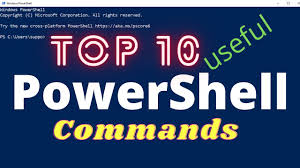10 Ways to Outsmart Your Competition with Windows Powershell Commands

10 Ways to Outsmart Your Competition with Windows Powershell Commands
1. Use PowerShell to automate tedious and time-consuming tasks. This will free up your time so you can focus on more important things.
2. Use PowerShell to do things that are difficult or impossible to do with other tools. This will give you a competitive advantage.
3. Use PowerShell to automate processes across multiple systems. This will improve efficiency and save time.
4. Use PowerShell to manage and monitor your system from a central location. This will make it easier to identify and solve problems quickly.
5. Use PowerShell to create custom reports and dashboards. This will help you track progress and identify areas for improvement.
6. Use PowerShell to automate backups and disaster recovery procedures. This will protect your data and reduce downtime in the event of a problem.
7. Use PowerShell to streamline software deployments and updates. This will reduce costs and ensure that your systems are always up-to-date.
8. Use PowerShell to monitor performance and capacity utilization metrics. This will help you avoid problems before they occur, and keep your systems running at peak performance levels.
9 .Use PowerShell scripts as tools for troubleshooting issues .This enables you To quickly identify And fix problems .
10 . Finally , use windows powershell As A platform For developing custom applications That solve specific business needs .This provides endless possibilities For improving efficiency And productivity In Your organization
ssh on windows
There are a lot of ways to use Powershell commands to outsmart your competition. One way is to use ssh on windows. This allows you to connect to a remote server and execute commands. This can be very useful if you need to make changes on a remote server or if you want to automate tasks.
To use ssh on windows, you need to first install the openssh client. You can find this in the cygwin package. Once you have installed the client, you need to generate a public/private key pair. You can do this by running the following command:
ssh-keygen -t rsa
This will generate a public key that looks something like this:
Your public key should now be copied to the remote server that you want to connect to. The easiest way to do this is to use the ssh-copy-id command. This will copy your public key to the remote server and set the correct permissions:
ssh-copy-id user@remote_server
Now you should be able to connect to the remote server using ssh:
ssh user@remote_server
You can also use scp to copy files between servers:
scp file1 user@remote_server:/path/to/destination
This will copy file1 from your local machine to the /path/to/destination directory on the remote server.
dual booting ubuntu and windows 10

One of the most popular configuration among Windows power users is to have a dual-boot system with both Windows and Ubuntu installed on their computer. This way, they can take advantage of both operating systems, using each for what it’s best suited.
If you want to set up a dual-boot system on your own computer, it’s actually not that difficult. In this article, we’ll show you how to install Ubuntu alongside Windows 10, giving you the option to choose between the two operating systems at startup.
Before we begin, there are a few things you should do first:
Back up your data: Before you make any changes to your system, it’s always a good idea to back up your data. That way, if something goes wrong during the installation process, you won’t lose any important files.
Disable fast startup: Fast startup is a feature in Windows 10 that helps your computer start up faster after a shutdown. However, it can also prevent Ubuntu from being able to access your computer’s hard drive, so it’s best to disable it before proceeding.
Create a recovery drive: If something does go wrong during the installation process and you can’t boot into either Windows or Ubuntu, having a recovery drive can be a lifesaver. This will allow you to troubleshoot and fix any problems without losing any data.
Once you’ve done
windows uefi mode
In today’s business world, competition is fierce. To stay ahead of the curve, you need to be able to quickly and efficiently automate tasks. Windows PowerShell is a powerful tool that can help you do just that.
One way to use PowerShell to your advantage is to run it in UEFI mode. This mode allows you to access and manage UEFI settings directly from the PowerShell prompt. With this level of control, you can easily change BIOS settings, view event logs, and even boot into different operating systems.
To run PowerShell in UEFI mode, simply type the following command at the PowerShell prompt:
powershell -ExecutionPolicy Bypass -File .\Enable-UefiBoot.ps1
This will enable the UEFI boot setting in your system’s BIOS. Once this is done, you can reboot your system and select the UEFI option from the boot menu. From here, you’ll be able to access all of PowerShell’s features and commands.
With UEFI mode enabled, you’ll have a significant advantage over your competition. You’ll be able to quickly and easily automate tasks, change BIOS settings, and even boot into different operating systems. So don’t wait – get started today and outsmart your competition with Windows PowerShell commands!
